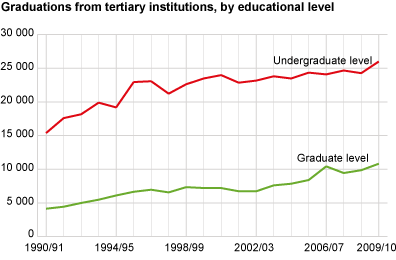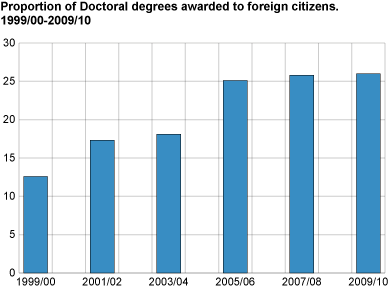Content
Published:
This is an archived release.
Increase in completed tertiary degrees
In 2009/10, 36 800 tertiary degrees were completed in Norwegian tertiary institutions; an increase of 2 700 from the year before. Students aged 19-24 years accounted for half of the completed degrees at undergraduate level, and students aged 25-29 years accounted for half of the degrees completed at graduate level.
The increase in completed tertiary degrees from more than 34 100 in 2008/09 to 36 800 in 2009/10, was the biggest since the mid 1990s. About 1 700 more degrees were completed at undergraduate level; an increase of 7 per cent from the year before. At graduate level, almost 1 000 more degrees were completed in 2009/10 than in 2008/09; an increase of 10 per cent. A partial explanation for the increase is an increase in relevant population age cohorts.
Undergraduate degreesUndergraduate degrees in tertiary education include programmes of four years or less, but also at least two years. Graduate degreesGraduate degrees have a cumulative duration of more than four years, but doctoral degrees are not included. |
About 65 per cent among those who completed an undergraduate degree in 2009/10 were women; a slight increase from the year before. Among those who completed a graduate degree, 54 per cent were women; a decrease of almost 2 percentage points.
New increase in doctoral degrees awarded
A total of 1 202 doctoral degrees were awarded in Norwegian tertiary institutions during 2009/10; an increase of 118 compared with 2008/09. The proportion of females awarded a doctoral degree remains stable at close to 45 per cent. The proportion of doctoral degrees awarded to foreign citizens continues to rise. In 1999/2000, only 12 per cent of doctoral degrees were awarded to foreign citizens, but the proportion grew rapidly to 25 per cent in 2005/06 and then gradually to 26 per cent in 2009/10.
The increase influences most fields of education
The increase of 1 700 in completed tertiary degrees at undergraduate level from 2008/09 to 2009/10, also caused an increase in all fields of education but one - health, welfare and sport, which faced a decline of almost 250.
At graduate level, there was a total increase in completed tertiary degrees of close to 1 000 in the same period, resulting in an increase in most fields of education. The largest increase was in natural sciences, vocational and technical subjects; an increase of 19 per cent from 2008/09 to 2009/10.
Almost one out of three women completed a tertiary degree in health, welfare and sport in 2009/10, whereas 26 per cent completed in this field among immigrant women and 36 per cent of Norwegian-born women to immigrant parents.
Among male graduations, 28 per cent completed in natural sciences, vocational and technical subjects. For immigrant men, this proportion was 39 per cent and 27 per cent of the Norwegian-born men to immigrant parents. For Norwegian-born men to immigrant parents it was most common to complete a tertiary degree in business and administration.
|
Proportions of Norwegian-born with immigrant parents completing a tertiary degree in 2009/10 by field of education are sensitive to even small changes, as the cohort is small. |
Tables:
- Table 1 Graduations in tertiary education, by gender, level of degree and type of institution. 1999/00, 2008/09, 2009/10
- Table 2 Graduations in tertiary education, by gender, level of degree and field of education. 1999/00, 2008/09, 2009/10
- Table 3 Graduations in tertiary education, by immigration category, gender and field of education. 2009/10. Numbers and per cent
- Table 4 Graduations in tertiary education, by gender, level and age 1999/00, 2008/09, 2009/10
- Table 5 Graduations, by gender, level and parents´ level of education 1999/00, 2008/09, 2009/10
Contact
-
Beate Bartsch
E-mail: beate.bartsch@ssb.no
tel.: (+47) 40 81 14 96
-
Nawid Fazli
E-mail: nawid.fazli@ssb.no
tel.: (+47) 97 09 77 18
-
Geir Nygård
E-mail: geir.nygard@ssb.no
tel.: (+47) 48 15 13 44


